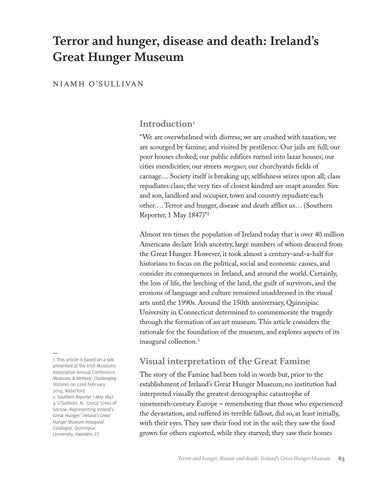Terror and hunger, disease and death: Ireland’s Great Hunger Museum N I A M H O ’ S U L L I VA N
Introduction1 “We are overwhelmed with distress; we are crushed with taxation; we are scourged by famine; and visited by pestilence. Our jails are full; our poor houses choked; our public edifices turned into lazar houses; our cities mendicities; our streets morgues; our churchyards fields of carnage.... Society itself is breaking up; selfishness seizes upon all; class repudiates class; the very ties of closest kindred are snapt asunder. Sire and son, landlord and occupier, town and country repudiate each other…. Terror and hunger, disease and death afflict us… (Southern Reporter, 1 May 1847)”2 Almost ten times the population of Ireland today that is over 40 million Americans declare Irish ancestry, large numbers of whom descend from the Great Hunger. However, it took almost a century-and-a-half for historians to focus on the political, social and economic causes, and consider its consequences in Ireland, and around the world. Certainly, the loss of life, the leeching of the land, the guilt of survivors, and the erosions of language and culture remained unaddressed in the visual arts until the 1990s. Around the 150th anniversary, Quinnipiac university in Connecticut determined to commemorate the tragedy through the formation of an art museum. This article considers the rationale for the foundation of the museum, and explores aspects of its inaugural collection.3 — 1. This article is based on a talk presented at the Irish Museums Association Annual Conference, Museums & Memory: Challenging Histories on 22nd February 2014, Waterford 2. Southern Reporter 1 May 1847 3. O’Sullivan, N. (2012) ‘Lines of Sorrow: Representing Ireland’s Great Hunger.’ Ireland’s Great Hunger Museum Inaugural Catalogue, Quinnipiac University, Hamden, CT
Visual interpretation of the Great Famine The story of the Famine had been told in words but, prior to the establishment of Ireland’s Great Hunger Museum, no institution had interpreted visually the greatest demographic catastrophe of nineteenth-century Europe – remembering that those who experienced the devastation, and suffered its terrible fallout, did so, at least initially, with their eyes. They saw their food rot in the soil; they saw the food grown for others exported, while they starved; they saw their homes
Terror and hunger, disease and death: Ireland’s Great Hunger Museum
63













